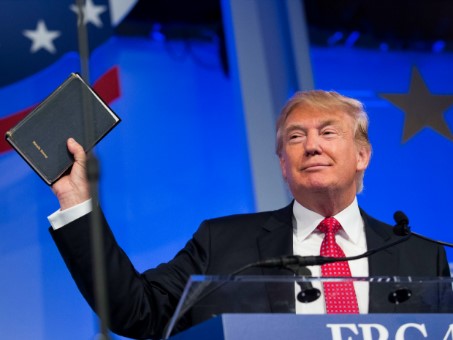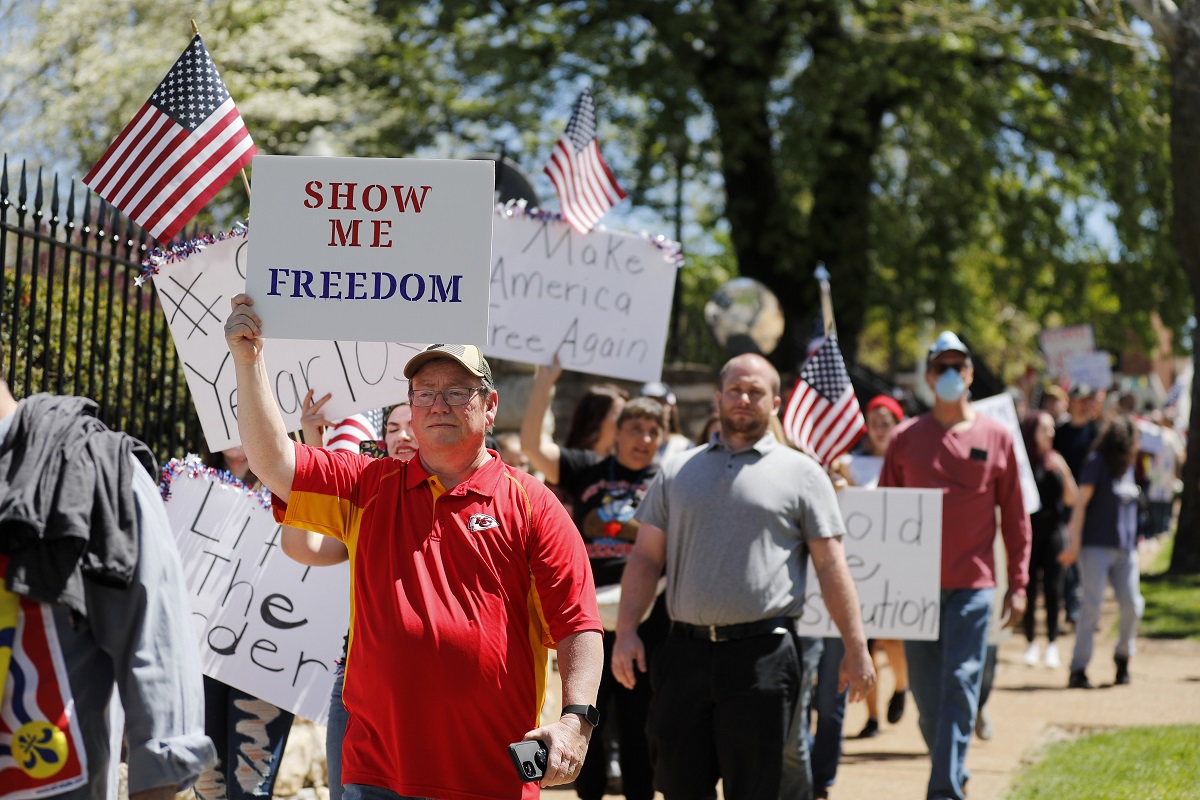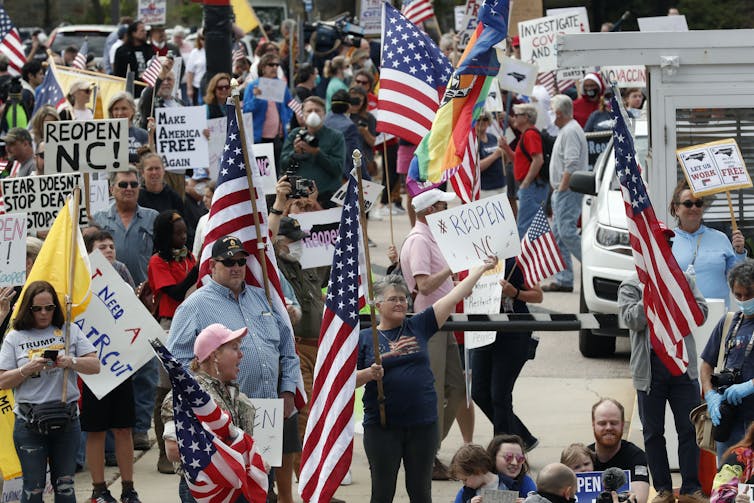BLEACH, LYSOL, KOOL-AID IT'S AN AMERICAN THING
Jim Jones and Donald Trump: Same Kool-Aid, Different Vat
by Kerine Hathill
FROM THE ARCHIVES

I have met neither Jim Jones nor Donald Trump. I have, however, listened to hours upon hours of each of them droning on about their ideology (or lack thereof), their interpretations of world events, and their perceived slights by outsiders. Before 2015, I was much more familiar with Jim Jones than I was with Donald Trump: I’ve been researching Peoples Temple for about 10 years and used to contribute tape transcriptions to the Jonestown Institute website. My recent familiarity with Donald Trump is like that of anyone who follows national news which naturally has been focused on the presidential race this year. Trump was unavoidable during the primary season; since he was formally nominated and, as Election Day draws near, he seems omnipresent. It makes me wonder if this is how Jonestown residents felt with the incessant blaring of Jones’ voice over the loudspeakers – sometimes live, sometimes on tape, but always inescapable.
And here’s the scary part: the more I hear Trump talk, the more he reminds me of Jim Jones. It is for this reason that I feel compelled to demonstrate how I came to this conclusion. Trump is not our country’s leader, and we should take steps to make certain he does not assume the reins of power. In my view, the last thing the United States needs is someone like Jim Jones as commander-in-chief.
My comparison between these two men may be surprising to many who would point out the marked dissimilarity in their ideologies. Jones the communist would be appalled by Trump the capitalist. Yet if one ignores fundamental philosophical approaches, parallels abound: disturbing personality traits, despicable behaviors, negative messages, and the use of persuasive speech. I address each of these below.
Here is my requisite disclaimer, which I feel compelled to make: although I have a Ph.D. in psychology, it is in physiological psychology (that is, behavioral neuroscience), so I am not professionally qualified to diagnose either Jones or Trump. Moreover, it is often considered inappropriate even for qualified individuals to diagnose people with whom they have not personally interacted. However, there is a mountain of publically-available information on these men, providing a great deal of documentation to support discussion of their personalities and behaviors. That they share characteristics of diagnosable psychological conditions is worth consideration because it may help to better understand the motivations behind these individuals. So, informal diagnoses, taken with a grain of salt, offer food for thought in terms of considering the psychological states of these individuals.

Personality traits:
I’ll begin with the diagnostic term thrown out on nearly a daily basis regarding Trump: narcissism. In a 2011 article for the jonestown report, Gary Maynard, Ph.D. made a strong case that Jim Jones fit the criteria for Narcissistic Personality Disorder. I will not repeat all of his points here. As for Trump, several people have asserted that he is a narcissist, including Dan P. McAdams, Ph.D., Professor and Chair of Psychology at Northwestern University, who wrote a treatment of Trump’s personality in the June 2016 edition of The Atlantic. In the article, “The Mind of Donald Trump,” McAdams wrote:
For psychologists, it is almost impossible to talk about Donald Trump without using the word narcissism. Asked to sum up Trump’s personality for an article in Vanity Fair, Howard Gardner, a psychologist at Harvard, responded, “Remarkably narcissistic.” George Simon, a clinical psychologist who conducts seminars on manipulative behavior, says Trump is “so classic that I’m archiving video clips of him to use in workshops because there’s no better example” of narcissism. “Otherwise I would have had to hire actors and write vignettes. He’s like a dream come true.”
So what is narcissism? As a personality trait, narcissism is marked by grandiosity, selfishness, and a strong desire for admiration from others. Taken to the extreme, it manifests as a personality disorder in which the person is manipulative, lacks empathy, and displays arrogance.
Narcissists desire constant attention. Jones attained this by keeping his flock in close proximity and controlling their lives. Trump gets his ego strokes by maintaining near-constant public focus on himself through campaign rallies, news appearances, and especially his Twitter account, from which he launches his rawest, most outrageous tirades free of the vetting of a campaign staff or the political party he purports to represent. The frequency of the mind-bogglingly offensive statements makes one wonder whether he does this solely for attention, as though he’s heeding P.T. Barnum’s adage: “There’s no such thing as bad publicity”.
Narcissism, however, would seem to be an incomplete description of the malignancy of these toxic personalities. Tony Schwartz – the principal author of Trump’s The Art of the Deal – recently stated that if he wrote the book today he would have called it The Sociopath. Building on this notion, James Hamblin, M.D., explored the closest thing to sociopathy that exists in the Diagnostic and Statistical Manual of Mental Disorders: Antisocial Personality Disorder. This condition is characterized by hostility, manipulativeness, deceitfulness, callousness, impulsivity, risk-taking, irresponsibility, and other traits. Trump’s behavior ticks most if not all the boxes on the diagnostic list. Previously – and not surprisingly – Jones has been characterized along these lines as well (see Burke, 2006).
The quintessential Trump statement that reveals the toxic marriage of his narcissistic and antisocial personality traits is found in his January 23, 2016 statement that “I could stand in the middle of 5th Avenue and shoot somebody and I wouldn’t lose voters.” It also struck me as a very “Jonesian” statement, but if you’re not convinced of the parallels between these two characters, consider the following examples of behavior and speech.

Requests/Demands for Loyalty:
Towards the end of one Trump rally in early 2016, the candidate asked that attendees raise their right hands and pledge to vote for him. His statement about being able to shoot someone and not lose any voters is as much a demand for loyalty from his followers as it is a demonstration that he has it. Compare these to Jones’ behaviors: he periodically had people pledge – verbally and/or in writing – that they were willing to die for the Cause. Jones also collected signed papers – sometimes blank sheets, sometimes written statements confessing to past or planned criminal activities – that he kept on file just in case someone thought about defecting. It gave him something to discourage them from leaving or – if they did – from speaking out.
Threats, Degradation, and Retaliation for Slights or Disloyalty:
Trump engages in very public tantrums in which he berates and derides his opponents or people who have betrayed him. Because these tirades are frequently done in front of a camera (say, at a campaign rally) or via Twitter, the attacks are available for anyone to see. A recent, notable attack was lodged at Alicia Machado, a former Miss Universe, whom Trump had “fat shamed” in the year after she was crowned when she gained considerable weight. After Hillary Clinton mentioned Ms. Machado in the first presidential debate on September 26, Trump spent several days tweeting degrading comments about Machado, including some posts tweeted in the wee hours of the morning. In a more recent scandal from early October, Trump was exposed engaging in what he described as “locker room talk” and which many other people have publicly called descriptions of sexual assault. Trump retaliated by holding a press conference shortly before the second presidential debate, in which he joined three women who had previously accused Bill Clinton of sexual harassment or assault. Finally, in an action more reminiscent of a banana republic dictator, Trump threatened his political opponent Hillary Clinton by saying she should “be in jail.” And when he raises the subject of Clinton’s emails during his rallies, the crowd cries out, “Lock her up.”
Trump’s behavior reminds me of some of Jones’ actions towards anyone who defected from the Temple as an enemy. He would publicly deride them in Temple meetings and allegedly threatened many who left. The major difference between Trump and Jones in this regard is that Jones’ wrath was voiced within the realm of the Temple, whereas Trump’s wrath is on display for all to see.

Money: Acquiring Other People’s, Bribing One’s Way Out of Trouble:
Over the years, the Peoples Temple’s coffers ballooned to millions of dollars in assets, the result of its members donating much of their income and property to the Cause. Insiders could argue that this was an investment for the members: the Temple fed, clothed, and housed the members who lived communally. Outsiders might say that Jones had exploited his followers, essentially bilking many lower income people out of whatever they had. If one considers Jones as a con man who stole people’s money based on false promises, though, one can also view Trump as an expert in the art of the con. We need look no further than the defunct Trump University, which was technically not a university at all. Numerous lawsuits have been filed by individuals who were sold courses in real estate investing with the lure that these people would become sharp real estate moguls like Trump himself. Some individuals were relieved of $35,000 for the premiere courses, spending either the bulk of their savings or actually accruing this cost as debt, yet never actually acquiring the knowledge and skills needed for success in real estate.
Of course, one can attempt to create a positive image and avert possible legal consequences from people who feel exploited by making a few well-placed bribes or donations. Jones was known to have given money to a variety of political campaigns, including to leaders whose decision could – and did – directly affect the Temple. Similarly, Trump gave a generous donation to the election campaign of Florida Attorney General Pam Bondi; miraculously, her office did not move forward with investigations into Trump University in response to complaints filed in Florida.
Denigration of Women, Sexual Improprieties, Assault Accusations and the Size of His Penis:
People are often alarmed at Jim Jones’ sexual indiscretions and crass talk about sexual conduct. It is well known, for example, that Jones had numerous extramarital affairs, and as some came to light, he or his defenders had ready-made excuses for the indiscretions. In public meetings, he would simultaneously brag and complain about having to “service” people – both men and women – within the congregation. Some of this conduct would be deemed non-consensual: consider former member Deborah Layton’s account of Jones’s pursuit of her, including raping her in a bathroom at the Temple; or a Temple leader’s admission and justification for Jones’ relations with a reluctant young woman. Jones is known to have called women out “on the floor” – that is, in front of the group at a Planning Commission meeting or even before the entire congregation – and publicly humiliate them. In one particular case, described by numerous people including Hue Fortson in Stanley Nelson’s documentary Jonestown: Life and Death of the Peoples Temple, a woman was ordered to strip in front of other Temple members, and then stand naked while Jones and others verbally denigrated the woman’s physical appearance. Jones also seized on many opportunities to describe his sexual prowess and stamina.
New reports and tabloids from decades ago revealed that Trump cheated on his first wife Ivana with Marla Maples, the woman who was to become his second wife, before he was divorced. Then, while married to Marla, Trump continued to engage in numerous infidelities. In the final weeks running up to the election, Trump stands accused of assaulting numerous women. Some of these accusations are decades old, but some were breaking as this article was being written. The shock value of the recent exposure of the Access Hollywood “hot mic” tape from 2005 revealing Trump discussing his inappropriate advances – as in, “assaults” – on women may be elevated even higher given that Trump had only recently married Melania, who was pregnant with his son Barron at the time of the recording. Trump is also one to boast about the size of his penis: at a Republican primary debate in the March of 2016, in defending himself on a comment made by Marco Rubio about Trump’s “small hands” – and by implication, a small penis – Trump stated that “I guarantee you there’s no problem there, I guarantee it.” That a comment of this nature would occur in the formal setting of a political debate is as inappropriate – even alarming – as Jones’ statements about his penis and sexual exploits occurring in a “church” setting.
Using the Bible

Peoples Temple began as a Christian church, and even as Jim Jones turned away from Christian beliefs and tenets, he retained his knowledge of the Bible. Jones knew it inside and out, including its contradictions and its descriptions of crimes such as rape and murder. The Bible was his to tailor his message at any given moment. While his knowledge likely appealed to many of the more traditional-minded (and older) members of his group, and helped to recruit others when Jones spoke in out-of-town churches during the Temple’s cross-country bus trips, a recurring image used by Jones’ critics is of the Temple leader throwing the Christian Holy Book to the floor, or suggesting that its pages should be used as toilet paper.

On the other hand, there is Donald Trump, known for bringing two books to some of his rallies: The Art of the Deal and the Bible itself. The problem is, one he didn’t write and the other he didn’t read, even if he uses the Bible to pander to the Religious Right. What should be problematic for Christian values voters in supporting Trump – yet astonishingly does not seem to be – is that he is remarkably ignorant of its contents. When asked about favorite Bible verses, Trump declined to give any. It was “too personal” for him, he said, and he didn’t want to discuss it. He wouldn’t even state whether he preferred the Old or New Testament. Eventually, after a number of days, Trump came up with “Never bend to envy” as his favorite Bible quote, one which doesn’t actually exist. Months later, Trump offered “an eye for an eye” as a favorite verse, an Old Testament passage which Jesus repudiated.
Links to Russia
One of the big controversies in Trump’s candidacy is his murky ties to Russia. He has given contradictory statements about whether or not he knows Russia’s leader Vladimir Putin. Russia’s leader is a “strong” leader, Trump says, a surprising compliment coming from a man painting himself as a conservative capitalist. Some suggest that Trump has financial ties to Russia and that the Russians may be involved in hacks of both the Republican and Democratic national committees. Trump denies these claims.
Jones’ links to Russia were relatively transparent. He was sympathetic to communism and an admirer of Josef Stalin. During Jonestown’s final year, Jones often spoke of relocating his movement to Russia as a way of getting away from the U.S. government’s persecution, an option which Christine Miller raised as an alternative to death on November 18, 1978. What is less evident is the degree to which Jones and his inner circle seriously considered this as a viable option for the community and how extensively this had been discussed with the Russian government. Like Trump, Jones’ connections to Russia are both mysterious and mystifying.

Playing the Savior, Bringing the Revolution:
Both Jones and Trump depict themselves as leaders of revolutionary movements, miracle workers who alone can save the people. For Jones, Peoples Temple was no mere church, it was a social and political movement that would fight against governmental oppression, racism, sexism, and poverty. Jones used faith healings to attract many of his followers, even though multiple accounts have revealed how many of these were faked. The Temple leader also promised his followers that he would deliver them to a utopia on Earth. Jonestown was to be the Promised Land, and its destruction – in Jones’ worldview – was due to the inability of the US to allow him and his followers to create a better world.
Similarly, Trump does not depict himself as a mere politician but rather the leader of a political revolution which will root out government corruption, hypocrisy, and waste. He paints himself as a non-politician who understands “better than anyone” how the political system is rigged, because he himself has worked that system. He alone can fix it and “Make America Great Again.” Trump aggrandizes himself as an economic miracle worker who created a multi-billion dollar fortune after receiving a “small loan” from his father. Like many Temple members, the followers of Donald Trump deny – or cannot even fathom – that their leader’s empire has been partially destroyed by bad business dealings and that his level of wealth is markedly lower than he claims.

Messages: Fear, Lies, Paranoia, and Violence:
Current political commentators are aware that a large part of Trump’s message to his supporters falls under the purview of fear-mongering. According to Trump’s view of the world; among other things, there’s plenty to fear: America is under attack from outsiders; Mexican drug dealers and rapists pour across the border as if it’s Swiss cheese, he argues, necessitating the construction of a wall along the entire border between the two countries; radical Islamists are also to be feared, and he may need to either completely ban all Muslims from coming into the US or merely impose “extreme vetting.” Trump also likes to tell blacks just how bad conditions are for them in terms of employment rates, poverty, crime, and violence. The employment and crime rates Trump quotes are hyperbolic, but that doesn’t mean his followers ever question the figures. Of course, when Trump refers to these numbers, he is usually in front of a predominantly white audience. When he speaks before blacks and Hispanics, he simply offers the pitch, “What the hell have you got to lose?”
Jones himself had fear to sell, and although conditions were bad for African-Americans, Jones told blatant, horrifying lies to portray a situation far worse than reality. His most famous is the claim of concentration camps being constructed for blacks in America. Prior to the mass emigration from the U.S., Jones often warned his flock that the American government was poised to start imprisoning blacks in concentration camps, but after the move to Jonestown, he filled his news reports with stories that concentration camps were already in existence. The message was clear: stick with Jones because you can’t go back to that hellhole.
Trump is a master of “Us vs. Them” thinking: you are either with him, or you are against him. People need Trump to save them from the danger brought by evil others, be they illegal immigrants, non-Christians, or Democrats. Anyone who speaks against Trump or withdraws support is an enemy, and he encourages persecution of them. Simply protesting at a Trump rally can result in being beaten up. There is simply no room for dissenting opinions. Jones, too, exploited divisions between groups. Although Jones described the government and its agencies as enemies and conspirators against them, he reserved his greatest contempt for defectors and members of the Concerned Relatives. On more than one occasion, Jones encouraged Jonestown residents to describe what they would like to do to defectors. Some of these involved graphic depictions of violence, and all of it was justifiable in Jones’ mind.
Hatred and distrust of the press is characteristic which Jones and Trump share. Jones truly felt persecuted by the press in the wake of the New West exposé that prompted his departure for Jonestown, and his distrust of the media would follow him to the end of his life. Trump likewise sees the press as tools of the enemy – unnamed special interests, GOP primary opponents, Hillary Clinton, and all Democrats – and laments on nearly a daily basis that the press is treating him unfairly, especially if a debate moderator tries to pin him down on a vague answer with a follow-up question.
For both men, accusations and critical statements about them are untrue – even when their denials can be demonstrated to be false. Indeed, one of the biggest similarities between Trump and Jones is their penchant for lying – and in Trump’s case, for his tendency to double down on his exposed lies. Both Trump and Jones counter their own false statements by offering the false statements of other people, as if this is an effective deflection away from their own lies. Moreover, as they both tell you, they speak the truth. Whenever I hear Trump’s oft-repeated “Believe me, believe me”, my mind flashes back to the so-called “death tape” of November 18, during which Jones tells his people: “I’ve never lied to you. I never have lied to you”.

A Notable, Important Difference between Jones and Trump: Their Followers
The followers of Donald Trump and Jim Jones share another similarity: they could not be more different from each other, or to a great degree, from the American society from which they emerge. People of color are rare at Trump rallies, and when they do show up, event organizers appear to go out of their way to position them behind the candidate so that news coverage of the event will capture them. Male Trump supporters outnumber female supporters. It’s difficult to know how many of them actually fit within the “Basket of Deplorables” to which Hillary Clinton has relegated them, but some have publicly made unabashed racist and sexist statements. Despite declaring themselves disenfranchised by the current conditions in the U.S., a recent survey indicates that the median income of Trump’s supporters is $72,000, notably higher than the median income of the entire U.S.
Compare these folks to Jones’ supporters. The Temple included people of all ethnic backgrounds, and by some estimates, blacks made up 85% to 90% of the Los Angeles and San Francisco congregations. Many, though not all, of the members came from lower-income households in inner city areas. These people felt disenfranchised, too, but it was arguably justified. Many had been on the receiving end of racism, injustice, and financial hardship.

SIGN AT ANTI PUBLIC HEALTH RALLY 2020

JONESTOWN 1979
Although the U.S. is far from a perfect country, current conditions reflect improvements for many people from minority groups, compared to the 1960s and 1970s when Jones acquired his following. Trump claims that America is in bad shape, but this doesn’t map on to objective reality by many measures. But the people who buy in to Trump’s message apparently feel that things are bad for them personally. To outsiders, it is difficult to see what Trump and his supporters are so disgruntled with, unless they feel their privileged status is about to disappear. In short, I find it much easier to comprehend the dissatisfaction with America felt by Jones’ followers than that decried by Trump’s supporters. But regardless of how bad things are and how disenfranchised people may feel, tearing it all down is not the answer. Electing Trump would be America’s Jonestown. We would be poisoning our entire country.


The Scariest Thing of All:
As this article has shown, Donald Trump and Jim Jones share many characteristics, but perhaps the most important, the most fundamental – certainly the scariest – aspect of their message is the manner in which they deliver it. They often speak in animated, staccato sentences that border on ranting, but carry the fervor of passion. Trump, like Jones, tells his followers that he loves them. They repeat their messages frequently, a well-known persuasion technique. Both men see themselves as straight-talking, down-to-earth saviors: the kind that use profanities and vulgarities as a way of making them “relatable”. Even if many outside their respective movements wonder, “how can anyone fall for that?” others are willing to follow. Unfortunately, following such a toxic individual has ramifications for many people, and not just for their followers. Conspiratorial talk of a rigged election by a Trump fearful of losing to Clinton has his supporters vowing to retaliate on his behalf, in the form of riots or assassinations as needed.
I can think of nothing more frightening than the ability of each of these men to do great harm by holding the fate of a large number of people in his hands. Jones inflicted the ultimate harm by taking over 900 people to their deaths; the pain reverberates today among Temple survivors, family members and friends, as well as others who have been touched by the tragedy. As horrific as Jonestown was, Trump has the potential to inflict much greater damage: if elected, he will have the nuclear codes and lot of potential targets among the 7.4 billion people on the Earth. I am not convinced that Donald Trump has any better ability to control his destructive impulses than Jim Jones did. Certainly, his verbal and Twitter tirades strongly suggest otherwise.
Temple members “elected” Jones by joining his movement and staying in it, and Jones had the ability to control the narrative of his followers by maintaining tight control over their living conditions. Once inside Jonestown, Jones became their sole source of news and information. Not only was “reality checking” difficult, but escape was nearly impossible, creating a perfect environment for Jones to authorize self-destruction of the community once outside pressures ramped up. His annihilation of enemies was not nearly as extensive as he envisioned – only four non-Temple members died that day, shot at the Port Kaituma airstrip – and his talk of death squads going out and taking care of Temple enemies turned out to be just that: talk. There was almost a complete destruction of the movement wrought by a leader, but his followers ranked in the thousands, not in the billions.


UH OH THIS IS NO LONGER TRUE HE HAS BEEN ELECTED
Fortunately, Trump has yet to be elected, and we are not living in a Jonestown-like environment. There’s publicly-available information against which people can check Trump’s claims. Doing so should assuage their concerns that America is circling the drain, necessitating a vote for Trump to save us all. More importantly, we have choices. We have power with our votes. Many reporters, bloggers, commentators and spin artists have used the “Drinking the Kool-Aid” metaphor in this election, and while it’s one I detest, I will follow up on it by imploring that you think before you drink, and take note before you vote. The future of a lot of people depend on the decisions we make now.
Sources:
Regarding the Psychology of Jones and Trump:
Burke, J. (2006). Antisocial personality disorder in cult leaders and induction of dependent personality disorder in cult members. Cultic Studies Review, 5(3), 390-410
Hamblin, J. (July, 2016). Donald Trump: Sociopath? Taking his biographer’s claim seriously. The Atlantic, retrieved from http://www.theatlantic.com/health/archive/2016/07/trump-and-sociopathy/491966/
Maynard, G. (2011). Jim Jones and Narcissist Personality Disorder (NPD). the jonestown report, 11. Retrieved from http://jonestown.sdsu.edu/?page_id=29416
McAdams, D.P. (June, 2016). The mind of Donald Trump. The Atlantic, retrieved from http://www.theatlantic.com/magazine/archive/2016/06/the-mind-of-donald-trump/480771/
Sources Addressing Jones’ Scandals:
Layton, D. (1998). Seductive poison: A Jonestown survivor’s story of life and death in the Peoples Temple. New York: Anchor Books
Reiterman, T. & Jacobs, J. (1982). Raven: The untold story of the Rev. Jim Jones and his people. New York: Jeremy P. Tarcher/Penguin
A Quick Guide to Trump’s Scandals:
Graham, D.A. (Oct., 2016). The many scandals of Donald Trump: A cheat sheet. The Atlantic. Retrieved from http://www.theatlantic.com/politics/archive/2016/10/donald-trump-scandals/474726/
(Katherine Hill is an Associate Professor of Psychology at Metropolitan State University of Denver and is a regular contributor to this website. Her views in this article are her own and do not reflect those of MSU-Denver. Her other article in this edition of the jonestown report is Harlequin Romance Meets Stephen King Meets Jonestown. Her complete collection of articles is here. She may be reached at hilltass@gmail.com.)
Originally posted on October 19th, 2016.
Last modified on November 14th, 2018.
Alternative Considerations of Jonestown & Peoples Temple
Welcome to “Alternative Considerations of Jonestown and Peoples Temple,” sponsored by the Special Collections of Library and Information Access at San Diego State University. This website is designed to give personal and scholarly perspectives on a major event in the history of religion in America. Its primary purpose is to present information about Peoples Temple as accurately and objectively as possible. In an effort to be impartial, we offer many diverse views and opinions about the Temple and the events in Jonestown.
Originally posted on January 5th, 2013.
Last modified on April 18th, 2019


























